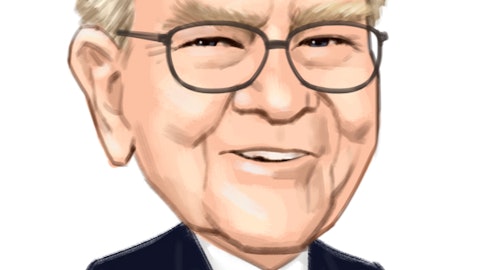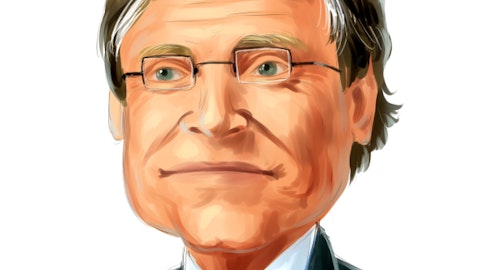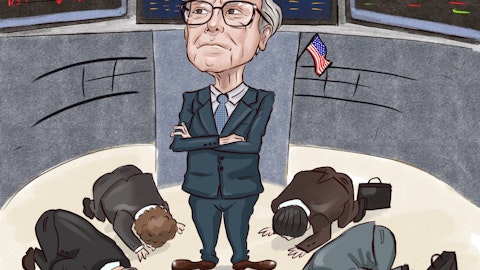John Baumgartner: Okay, thank you.
Carlos Abrams-Rivera: Fair questions, John.
Operator: Thank you. [Operator Instructions] Our next question comes from Stephen Powers with Deutsche Bank. You may proceed.
Stephen Powers: Great. Thank you. Good morning. I wanted to shift gears, if I could, and talk about the momentum you have in both Foodservice and Emerging Markets and just get your perspective on your confidence that momentum can continue and perhaps how the organizational changes that you announced today internationally might contribute to that momentum as we go forward. And also Andre, if you could, if I could tack on a second question, just now that leverage has dipped below that target level of 3x, just wondering how you’re starting to think about prioritization of cash going forward. Because the cash generation has been good, I presume cash will build and just think about how you’re thinking about allocating that cash going forward. Thank you.
Carlos Abrams-Rivera: Thank you for the question, Stephen. Andre, why don’t you comment on the capital allocation, then I’ll talk about Foodservice and Emerging Markets.
Andre Maciel: Sure. So on capital allocation, our priorities remain unchanged. That means continue to fund our very competitive dividend, maintain investment grade and prioritizing organic growth like we have been consistently doing during the past 3, 4 years. We are very proud that we were able to get to this level of leverage 1-year ahead of our initial expectation, and that’s very important. That shows that the business is strong and the organization is focused on delivering sustainable performance not only on the EBITDA side, but also in cash conversion, which is a remarkable improvement of this organization. And now I think that puts us in a very good situation to assess options to deploy this cash, and we are looking at those.
Carlos Abrams-Rivera: Thanks, Andre. Let me comment first on Foodservice. I feel very optimistic about our plans in Foodservice. And we have really been working on building a foundation for the future. And if you think about the way we are thinking about building our business in basically three areas, we continue to make the investments in our chef-led models and that’s driving positive performance for us. We also are making sure we are competing in more attractive and better margin channels, things like our independent and non-commercial channels versus traditional where we have been limited to. And then lastly, we are seeing much more powerful innovation that allows us to lever the technology investments we have made and bring those into the product forefront, whether that is in things like our Heinz Remix machines and how that actually creates an opportunity for us to separate ourselves for the future.
Now if you look at the full year for Foodservice, our expectation is probably to grow somewhere in the low to mid double digits versus last year. And we are – I will point out that we’re gaining share too, in both North America and the international zone. And then let me just make sure also that it’s clear that if we think about our long-term algorithm, Foodservice is expected to grow about 5%, and we’re going to be well above that level in 2023. Now if I switch over to our Emerging Markets, the one great thing that we also have been investing behind in Emerging Markets is kind of the discipline of our go-to-market model. And for us, the reason we feel so confident is because there is a data-driven go-to-market model that allows us to drive distribution, that then – we can then build and press in existing markets and enter new ones.
And we have done that several locations. In fact, we are on track to implement our model in 90% of Emerging Markets by the end of this year. And just to remind you, in things like – in the first phase of building distribution, we would build the infrastructure, and then we go into the full structure in order to truly take advantage of our emerging business. I think in Emerging Markets, I would just add the comment that in Q3, we saw a temporary headwind as we think about particularly in Asia, where we have a business in Indonesia that is most surrounding around Ramadan season and where we saw some travel shifting – spending shifting from travel, away from gifting, and we have a gifting business in Indonesia. So that was that was a temporary thing.
But as we think about the year ahead, we believe that we will get back to the right levels of performance also in our Indonesia business. Thanks for the question.
Stephen Powers: Thank you.
Operator: Thank you. [Operator Instructions] Our next question comes from Ken Goldman with JPMorgan. You may proceed.
Ken Goldman: Hi, thank you. Just a quick one. In your slide presentation, from the prior quarter 2Q, you mentioned that you were expecting positive volume growth in 2024. I may have missed it, but did you reiterate that today in either of the slides or any of your commentary?
Andre Maciel: Yes, we did. And that’s the case. Nothing changes. So nothing changed in terms of volume expectations as Carlos said. So we said, and it happened that volume would improve in Q3 sequentially to Q2, and it did. It improved in Q4 versus Q3. And at some point in 2024, the volumes will turn positive.
Carlos Abrams-Rivera: In fact, I think everything that we’re seeing right now in the market, in our actions are working. And it just gives us more confidence as we think about our 2024 plans.
Ken Goldman: Sorry, can I just quickly clarify that? I think people interpreted the commentary about positive volume about – as net throughout 2024, it will be positive. But I think the comment that was just made was at some point in 2024, it will turn positive. I guess I’m curious, do you expect at the end of the year, your total 2024 volume to be positive? I just wanted to get a sense that people aren’t overmodeling the year.
Andre Maciel: I am not going to give guidance for 2024 right now. What I just said is what we have been saying all along.
Operator: Thank you. [Operator Instructions] Our next question comes from Michael Lavery with Piper Sandler. You may proceed.
Michael Lavery: Thank you. Good morning. I know we have covered maybe a little bit just on the volume and how to think about its role in the portfolio side, but I want to just come back to one specific piece. You have talked about your approach and being disciplined and rational. But in your prepared remarks too, you also specifically said that in cold cuts, you are investing to hit the right price points. Can you just maybe unpack that a little bit and reconcile how those two go together and what exactly you mean by those investments on the price side?
Carlos Abrams-Rivera: Yes. Good question. Happy to clarify, Michael. What I would say is that we need to make sure that we are responding to the moments in which consumers are going to be looking for the right solutions for whether it’s at the holiday seasons or all the points throughout the year. And as we go into Q4, for example, we will make sure that we are making the right investments. However, we will be doing that with the right level of discipline to make sure we drive the right returns on that investment. So, the idea is that we have simply – like we stated earlier, we are not going to just be chasing volume, we are going to be looking for what is the way for us to drive profitable volume in a way that combines our ability to continue to build our businesses through the right investments in marketing and using the full array of revenue management tools in order for us to be able to drive the right efficiency and effectiveness of our investments.




